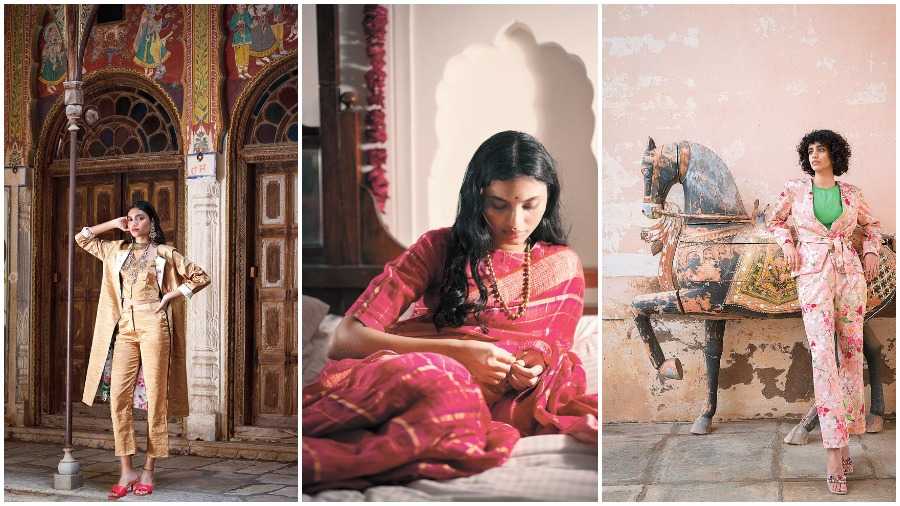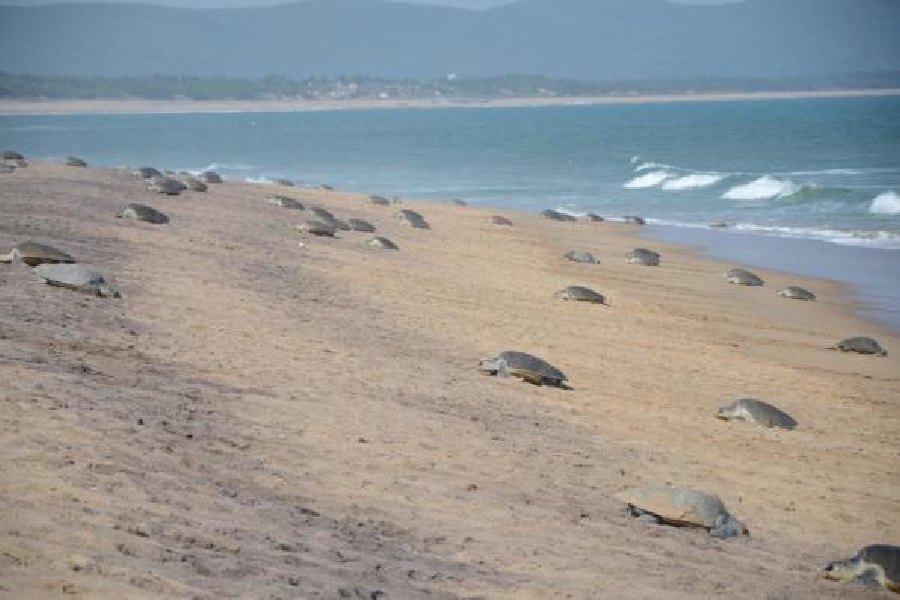Anavila’s Morakasi, a festive 2021 edit, is a celebration of the traditional, rendered modern. Full of gorgeous metallics, solids and romantic florals, the collection has drawn inspiration from the vintage Shekhawati havelis and their fresco art. Anavila Misra spoke to The Telegraph just ahead of Diwali about the making of the collection and what from her childhood days brings a smile to her face.

Anavila Misra
Morakasi looks spectacular. We love the name, which means ‘fresco’. How did you decide on the name?
I have been intrigued or fascinated so to say with the Shekhawati havelis for a very long time. I have a friend who works for a few organisations who do developmental work in that region and she has been going there for the last seven-eight years and whenever I met her, she would talk about the Shekhawati festival, the havelis and show me pictures. It is like something which is running at the back of your mind... you have not visited and not done anything about it. It had been like that for a while with me and Shekhawati.
Then during the lockdown, I got this opportunity to visit and see the place and I was completely mesmerised. I have seen palaces and forts before and visited Rajasthan... Jodhpur and Jaipur, but there was a strange intimacy in these havelis. They were the living quarters of many merchants and it was made for a household to run. This personal expression of people being put together in different ways using the same art was something which completely captured my attention and I really wanted to work on it. The kind of colours which come through and the techniques which are used, even the flow of the pastels to very bright colours, which are synonymous with Rajasthan... but at the same time, it is so nice to see certain patterns used in a way which is contemporary. Just the study of these havelis led me to work with botanicals and certain colours which I picked up for this collection.
It is not surprising that they appeal to you as your work is so much about the power of the hand and the craftsmanship of the havelis is mind-blowing. How overwhelmed were you to see the work up and close?
I was thinking what you saw there was done years ago and you don’t get that sense of time which would have gone into creating those and it’s not only the perfect harmony of the fresco art which is there, but also the person who has carved the wooden door or the person who has worked on metals. There is a close-up of a window jharokha which is intricately carved and decorated with seashell details. Each and every corner has such beautiful details... the fresco painting, the glass work and the woodwork and the coming together of all that.... I don’t know how many days and months it would have taken.
Did you shoot this in one of the havelis?
We shot it in two havelis and one fort.
We love the florals. How have the inspirations translated into your work?
The local flowers like the kaner, which is a pink flower, then the desi gulab and even madhumalti... they use flowers to define the colour. When they say kaner, they mean pink and pevri is yellow and then this whole beauty of using the same names, I really wanted to do that. Frescoes are something else and what we have tried to do with our clothes is a contemporary take on what we saw, but to keep the names which are culturally used over a very long time, I wanted to have that connection with the place. All our styles are named using words from their local dialect.
Somewhere we have just splashed bright colours, greens or the pinks, on the trousers especially, it is Rajasthan for me... those colours. There was a huge flow of pastels and muted tones getting into bright colours. That’s what you see in our collection too. There are pastels with just silver borders, but they have been combined with these blouses which are bright botanicals. I wanted to mix that in the silhouettes we have created.
The saris are pure love as usual...
Also because this is a festive collection, I wanted to keep that intact in terms of the colours of the sari. We have silk-based zaris and we call it hilkari saris because hilkari is the gold and silver work they do on the frescoes. I have done yellow with yellow, green with green... kind of doing the same colour but different tones... like you wear a green trouser and you wear a green garden shirt, it just is so beautiful and contemporary.
You have done a smattering of western silhouettes. Are you looking at getting into more and more western silhouettes also?
No, no. So, if you see the garden shirt we have done, it is the improvisation of a kurta, which you can wear like a long shirt dress or pair it with trousers. The idea is to do a contemporary look on the kurta itself.
The jackets are such that when you are wearing western clothes, you can pair them with these jackets. If you have to go to a party from office, just throw on the jacket on your denims. It goes very beautifully with the saris also. It’s just an extension of how we see our customers using our clothes and what are the bits and parts they want to create to complete their wardrobe and that’s how you see these trousers and jackets in the collection.
Any investment pieces for you this season?
I feel a beautiful festive layering like a jacket is a must. It’s versatile in terms of a garment. Then, I would say the whole metallic look of a sari or if you are more comfortable in a kurta, then a kurta. You can wear it to a party or for any festive occasion. You just need a small jewellery piece or a flash of colour to complement it. A nice pair of trousers is also a good investment. That’s how we have put together our trousers too. We have gold and silver, which goes with everything. Then we have pinks. If you wear a short top and wear those bright pink trousers with huge earrings, you are ready for a party.
Since you have tried to capture the spirit of homecoming in the collection, what are your favourite memories from your growing up years which have stayed with you?
I think I was in class IX or X when I wore a proper formal sari for Diwali and my father looked at me and smiled. During Diwali that memory stays. Also, we were in a small town, in Karnal. (There was this ritual) of giving sweets to all the households and decorating together. I remember 15-20 days prior to Diwali, my mother and her friends would go to one house and join in, in making the Diwali mithai. There was such bonding. Now I just go to the market and buy some boxes of mithai but that process of creating with your hands and together was what festivals were all about those days.











